Address any questions or comments regarding this newsletter to the individual authors listed after each article or to its editors, Nathan Johanning, 618-939-3434, njohann@illinois.edu or Bronwyn Aly 618-695-6060, baly@illinois.edu. The Illinois Fruit and Vegetable News is available on the web at: http://ipm.illinois.edu/ifvn/. To receive or be removed from email notification of new postings of this newsletter, contact Nathan Johanning or Bronwyn Aly at the phone numbers or email addresses above.
In This Issue:
Upcoming Programs ((listings for beginning and established growers))
Regional Reports ((west central, southern Illinois, Dixon Springs))
Fruit and Vegetable Pest Management ((Modified Growing Degree Days from Jan 1 through June 4, USDA Fruit & Vegetable Advisory Committee Report, The Public and their Animals: Regulations and Risks on Your Direct Market Farm, Potato Leafhopper in Apples, Green Beans, and Potatoes))
Upcoming Programs
Check the Illinois SARE calendar for a full list of programs and links for registration.
http://illinoissare.org/ and http://illinoissare.org/calendar.php
Also see the University of Illinois Extension Local Food Systems and Small Farms Team’s website at:
http://web.extension.illinois.edu/smallfarm/ and the calendar of events at http://web.extension.illinois.edu/units/calendar.cfm?UnitID=629.
- State Horticulture Field Day, Thursday, June 13, 2019, 8 a.m. Tanners Orchard, 740 State Rt. 40 Speer, IL 61479. Sponsored by the Illinois State Horticulture Society. For more details and tickets visit www.buytickets.at/ishs or contact Jenna Spychal 217-254-5258 jenna@jonamacorchard.com
- 2019 Southern Illinois Summer Twilight Series Dixon Springs Agricultural Center, Monday, June 17, 2019 at 6 p.m. The second Southern Illinois Summer Twilight Meeting will be held at the University of Illinois Dixon Springs Agricultural Center 354 State Highway 145 N, Simpson, IL 62985. Local Foods/Small Farms Educators, Bronwyn Aly and Nathan Johanning, will be hosting this meeting, highlighting current high tunnel research and demonstration trials and production practices being utilized in the Local Foods Area at DSAC. Dr. Wenjing Guan, Purdue University, will be discussing the ongoing cucumber trial and basic vegetable grafting. For more information or to register, please contact Bronwyn Aly, baly@illinois.edu ; 618-252-8391.
- July 8, 2019 – Mileur Orchard to host 3rd Southern Illinois Summer Twilight Meeting
- August 19, 2019 – Jackson County Extension Office to host final Southern Illinois Summer Twilight Meeting
- Produce Safety Rule Mock Audit, Tuesday, June 18, 2019 time TBD ** Farm on Ogden, 3555 Ogden Ave, Chicago, IL 60623. Please join Cook County Extension Educator, Zack Grant and FDA Consumer Safety Officer, Theresa Klaman for an informal walk around of Windy City Harvest's Farm on Ogden operations. We'll look at the outdoor production areas and all pre-harvest, harvest, and post-harvest areas from the perspective of the FSMA Produce Safety Rule with an opportunity for open Q&A. Please register for this free program at www.go.illinois.edu/MockAudit. For more information contact Sarah Batka at 708-679-6889 or sbatka@illinois.edu.
- Master Urban Farmer Training Program (MUFTP) This 11 week program is scheduled on Wednesdays, June 19 - Aug 28, 2019 from 5:30 - 8:30 pm. Training location is Prairie State College Matteson Area Center, 4821 Southwick Drive, Matteson, IL 60443
This program is best suited for:
- Entrepreneurs who want to start an intensive urban produce farm operation.
- Community leaders in underserved/food insecure communities who want to develop their food production skill set to increase food security and establish a community food system project in their neighborhood.
- Master Gardeners and Naturalists interested in intensifying their food production skill set.
- Educators who want to bring food production knowledge back to their organization.
Interested parties can apply through June 7 at https://go.illinois.edu/MUFTP. For more information contact Sarah Batka at 708-679-6889 or sbatka@illinois.edu.
Regional Reports
From west central Illinois (Quincy)… We finished asparagus harvest on Memorial Day, almost 6 weeks after we started. It was an average year, with very cool temperatures along with very hot temperatures really causing disruptions in daily pick amount. We had low asparagus beetle populations, they seemed to build and then we’d get hit with torrential rains, and the population seemed to decline somewhat. We did notice an earlier appearance of seedling weeds, which is probably due to the high rains leaching the pre emerge herbicide out of the seedling zone.
When we retire the patch for the year I’ll evaluate what weeds are present and make a determination of using glyphosate or gramoxone along with a pre emerge (for a full listing of recommended products consult the Midwest Vegetable Production Guide). If dandelions are concerning, I’ll use glyphosate, otherwise gramoxone. The important thing to remember is if using glyphosate, to mow off all the spears 1-2” about ground so that they won’t translocate the glyphosate down to the root. Gramoxone will not translocate so you can spray on emerged spears, just note that those emerged spears will die, but it won’t harm the crown.
The buffalo gnats are worse this year than I’ve ever noticed them. Our one asparagus field is located south of a subdivision, which dramatically reduces the wind (houses and trees) so that even the 15-20mph (and higher) winds that we’ve been receiving don’t drive away the gnats. It’s almost impossible to be out unless you’ve spritzed yourself with Buggins, vanilla extract or Absorbine Junior. I’m sure there are other remedies but these have proven successful with me, although they will only last for 1.5 hours or so before reapplication is necessary.
Our strawberry crop this year is the worse we’ve ever had. I finally figured out why. We had a low temperature in January of -13. And unfortunately a few days prior to that we had rain which melted the 5-6” of protective snow and left ½-1” of ice on the covers. That ice radiated that cold temperature down to the crown, which killed the buds. We’ve got big beautiful plants, 15-18” in height, with 4-5 crowns with not a single berry on them. I’m estimating we have about a 10% crop. The few rows of bare root berries we planted in July that we covered with straw look great. We started picking May 25th, and did note a larger percentage of anthracnose on some of the berries, depending upon variety. Not that we didn’t expect it with the constant rains. How wet is it? Well we plant on 6-8” raised beds, and at times, the water has flowed across the top of them in the low areas of the field.
We had 2 days during the month of May when we could do any field work, May 16-17, and then it started raining at 10am on the 18th. During the month of May it rained 20 days of 31. And June didn’t start out any better, we had another “terrace topper” rain (.5” in 10 minutes) on Saturday the 1st. I’ve lost track of how many of those intense rains we’ve had this spring. Needless to say, things are kind of getting out of whack. But we did manage to get in some more sweet corn and green beans planted during those two days of May. We also got in a few cucumbers and peppers on plastic. One thing we’ve noticed with both sweet corn and field corn, the emergence is not very uniform. The wetter areas of the field, with less available oxygen, are not emerging well, or at all.
Our last planting of sweet corn should have been planted around May 28th, but we’ve been unable to get into the field, and even today, June 4, it’s too wet to plant. I’m not sure if we’ll get the last planting in or not as rain is forecast for the next few days. This has been a spring unlike any other!
I will say I’ve never seen our onions look as good as they do now. Apparently we’ve not been irrigating them enough in past years! Although this year I’ve yet to hook up the irrigation.
High tunnel crops are doing great. We’ve got tomatoes and peppers sizing up well and the greens look great.
Mike Roegge, Retired Extension Educator & Mill Creek Farms (roeggem@illinois.edu)
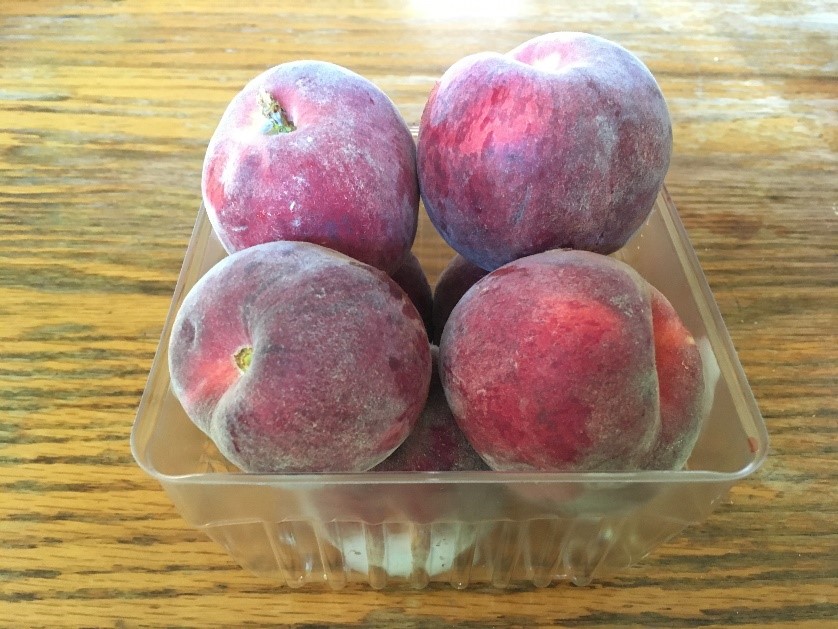
‘Early Treat’ peaches from southern Illinois. Photo: N. Johanning
From southern Illinois... We finally did get a small break from the rain last week which allowed most growers to get some field work done. This week rain has been spotty on rainfal totals. In Murphysboro we had 0.8” over the weekend, Wednesday morning we had 0.5” and Thursday morning we had 1.4”. During this same time at the Ewing Demonstration Center we only had about 0.6”most of which came Thursday morning. We have rain chances all through the weekend, but by the first of next week we are supposed to have a dry stretch of weather. Highs have mainly been in the 80s with a few days up around 90˚.
Out in the field, as of about a week ago I ate my first southern Illinois peach. ‘Early Treat’ lived up to its name as the juice ran down my chin on May 31st. As with most early peaches maybe not quite as good as some of our later peaches in July and August, but it was still delicous! Other things in harvest are red raspberries, peas, greens and we nearing the end or latter part of strawberries.
With the dry weather we finally got some field work done here in Murphysboro. We transplanted a tomato trial comparing no-till with a rye cover crop to and tillage after a rye cover crop. We could have planted the the trial a few weeks before as we could have transplanted in the no-till, however it was not dry enough to till the tillage treatments. It was still a little wet, but not knowing when the next rain would come when went ahead. The end of last week we made our final harvest on our asparagus variety trial. The weeds especially nutsedge were getting a little out of control and with the heat spear quality had gone down. The harvest season had been slow up until the last few weeks where we actually had temperatures up around 80˚ or above and things really got moving. We mowed down any spears and stubble left in the field after the last harvest and applied Gramoxone, Dual Magnum (with the new idemnified label for IL. See IFVN 25:5 for more details), and Sencor along with Crop Oil Concentrate. Prior to this, I also spot sprayed some perennial broadleaves/volunteer trees with 2,4-D. The birds that feed on some of the asparagus berries are more than generous in also bringing mulberry seeds among others. For us, I think this will work well and between this and the early season burndown we have utilize 6 different herbicide site of actions so we are trying to avoid promoting and weed resistance issues. At times this comination may sound like a lot but you have to remember that this is a perennial crop and 1) weed competition can severly limit the overall productivity and life of the planting and 2) if perennial weeds aren’t managed or annuals are left to go to seed the populations will only get larger and harder to manage in the future. We also applied about 50 lbs of actual N/A, banded right over the rows to help give the asparagus a boost to fern out and start rebuilding the crown for next year. Note we did not broadast it as that would only boost weed growth in the row middles where we are already trying to reduce weed growth. For full recommendations for pest management in asparagus or other crops consult the Midwest Vegetable Production Guide.
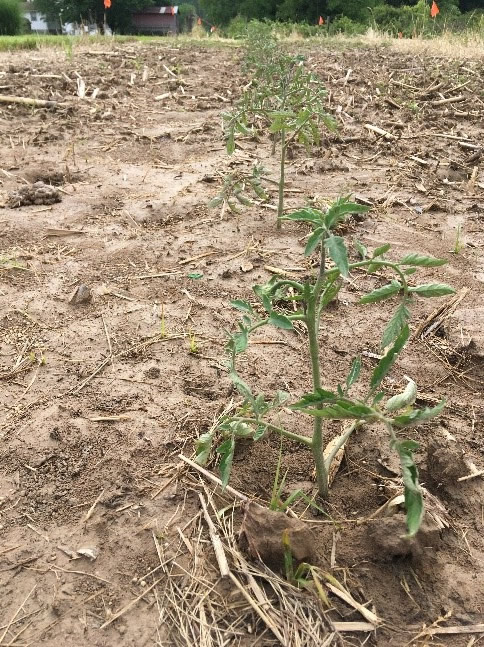


Tilled (left)and no-till (center) tomatoes after cereal rye. Asparagus variety trial one week after final harvest and herbicide application (right). Photos: N. Johanning
We had some old plasticulture beds the we worked down and seeded to a summer cover crop. We planted cowpeas (100 lbs/A) and pearl millet (30 lbs/A) together. We broadast them on tilled ground and then ran a spike tooth harrow across it. This picture is now (below) 1 week after planting. We were looking for weed suppression and probably went a little higher than necessary on the seeding rates, but I will keep you posted on how things go. So far I can’t complain after only a week.
We also “broke ground” on a new research field at my office in Murphysboro. This area was a grassy mowed area, many years ago a softball field. I plowed the about 2/3 acre area this week prior to the latest round of rain. It was a little wet and did not plow very pretty with the sod, but it worked. If the weather will cooperate we will get it worked down and have some trials in it yet this year. This area will support some upcoming grant funded projection looking at no-tillage systems for tomatoes and peppers among many other projects. With the addition of this, we have over 1 acre in production research fields at the office plus the high tunnel.
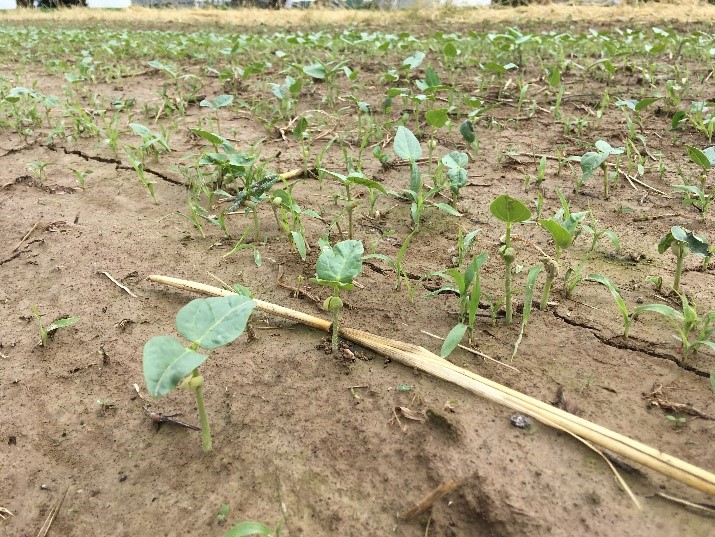
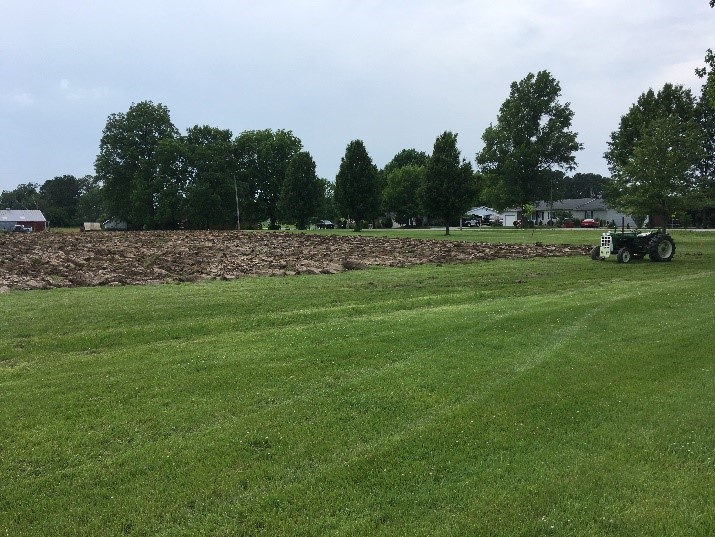
Summer cover crop of cowpeas and pearl millet one week after planting (left). New research field at the Extension Office in Murphysboro. Photo: N. Johanning
Nathan Johanning (618-939-3434; njohann@illinois.edu)
From Dixon Springs Ag Center…I am always amazed at how fast plants can grow in just two weeks time. In the last newsletter, my update included peppers almost ready to bloom and determinate tomatoes needing a second string. Well this time peppers have set their first fruits, tomatoes are on their third string, and we are starting to harvest the second flush of hydroponic strawberries! We have made 2-3 cuttings on herbs in both the hydroponic and in-ground tunnels, cucumber harvest is remaining steady, and we have lots of green tomatoes anywhere from tennis ball to softball size. Last week saw the first spray in the hydroponic tunnel for the lions, tigers, and bears, I mean aphids, mites, and thrips. With the help of one of my summer interns, I have been able to start collecting prices at a few farmers markets in southern Illinois so the Illinois Farmers Market Price reporting is back in 2019. Prices are submitted weekly and can be viewed at http://www.uky.edu/ccd/pricereports/ILFM . Also, previous years’ price reports have been archived and can be accessed from this link as well.
In the bottom set of photos, a side by side comparison can be seen between a solid row of ‘BHN 589’ determinate tomatoes that have received no fertilizer, water only, to a row with multiple varieties within a replicated variety trial that has received starter fertilizer and weekly fertigations alternating between 3-15-28 and 15.5-0-0. The ‘BHN 589’ has received no fertilizer based on the soil sample taken this spring from that row. Plants are dark green with lots of foliage but the first fruit clusters seem a bit sparse. The topmost flower clusters appear to be a lot more robust. The other row appears to be setting very heavy fruit loads with much less foliage cover, although varietal differences can be seen between plots. I am predicting that we will have ripening fruit in time for the June 17, 2019 Twilight Meeting so mark your calendars and make plans to attend!
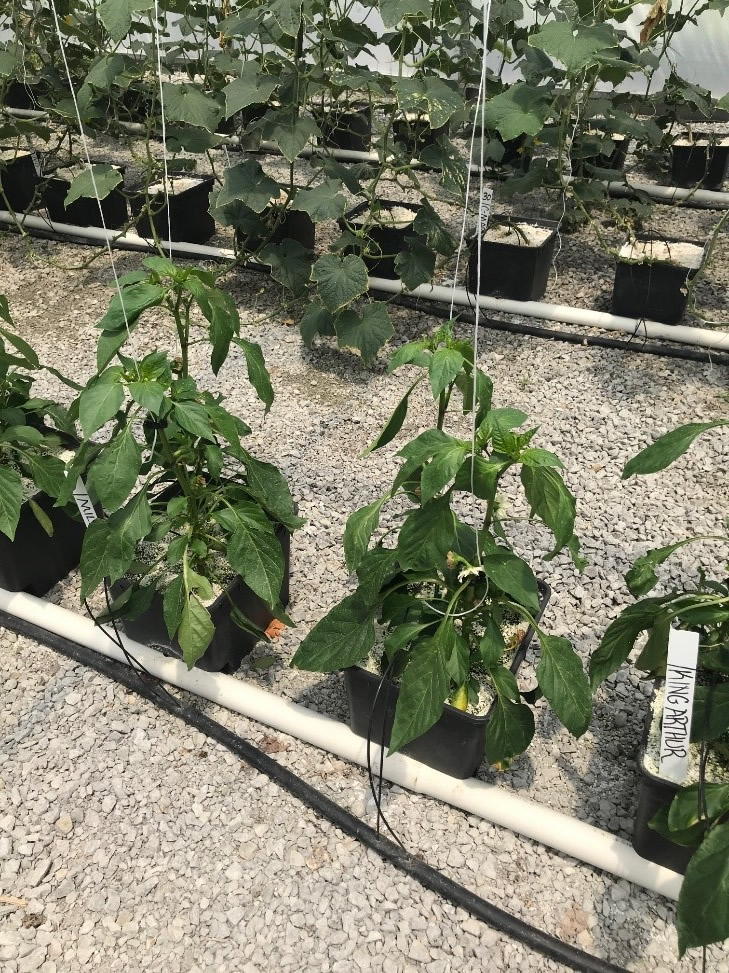
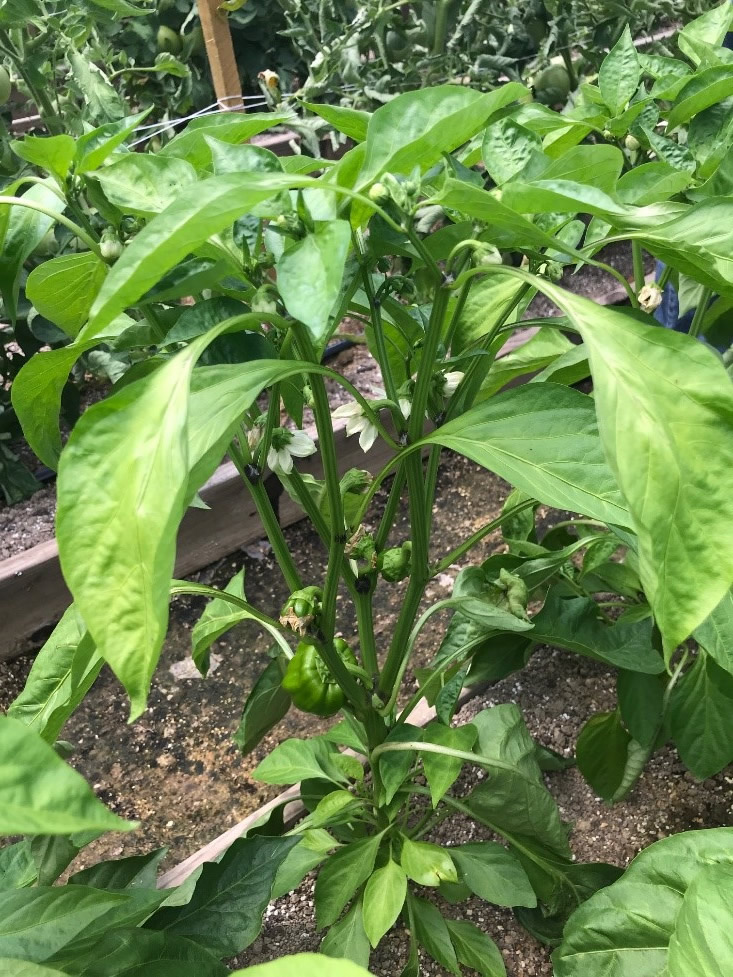
‘King Arthur’ bell pepper cultivar being grown in both the hydroponic tunnel and the in-ground, raised bed tunnel. The hydroponic plants were set almost 1.5 weeks later than those in the ground beds but have almost caught up, with both setting and sizing fruit similar in size. Photos by B. Aly.
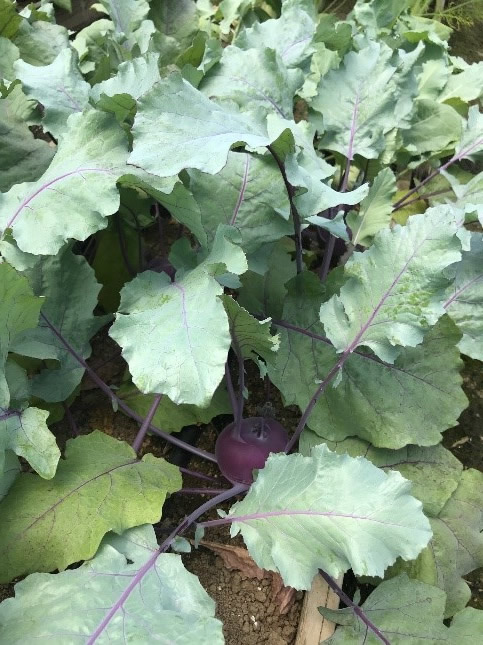
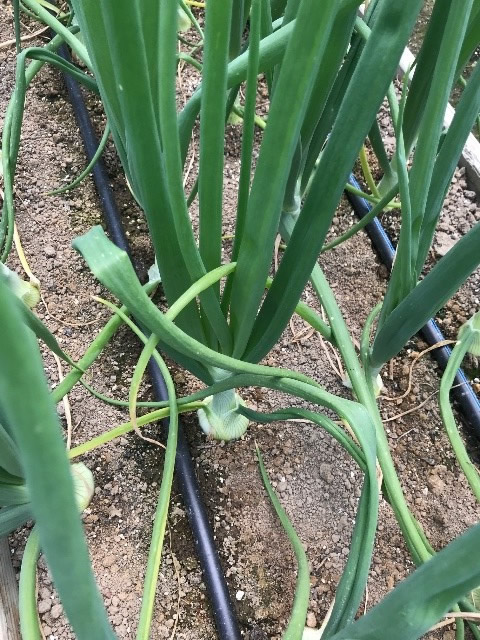
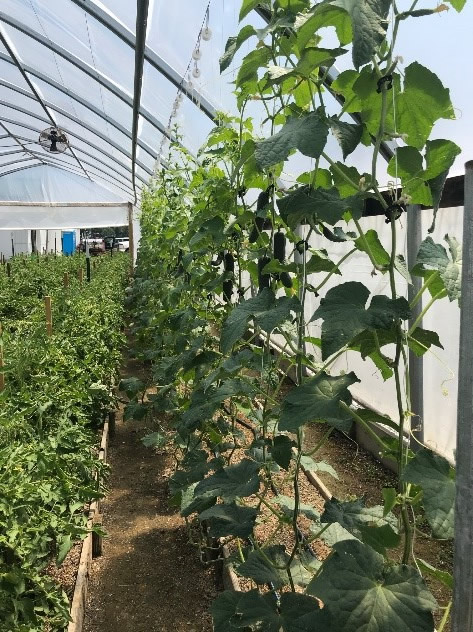
Photos by B. Aly. Photos left to right: Kohlrabi, ‘Candy’onion, seedless cucumbers trellised to single line. Crops are really growing well in the raised bed high tunnel.
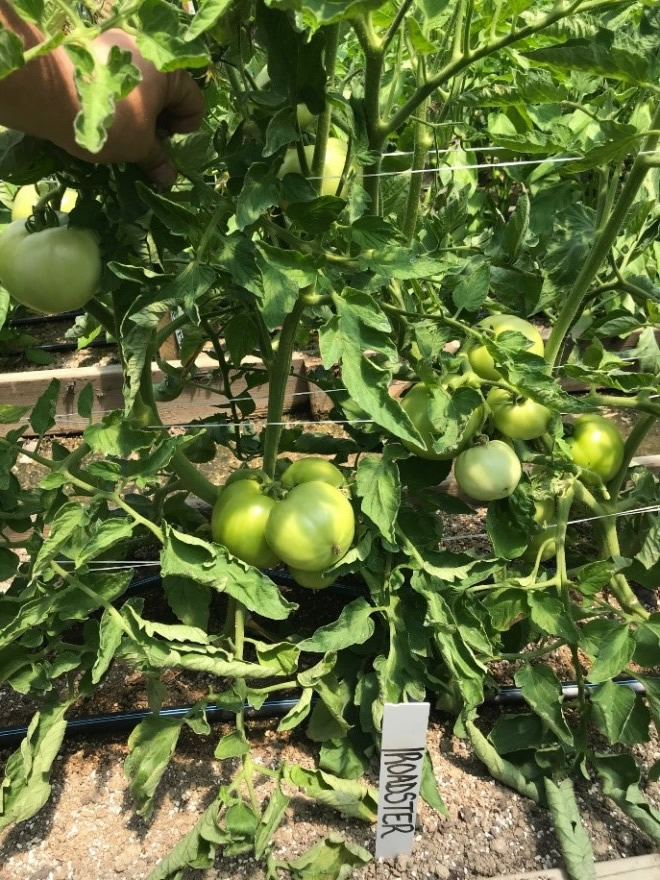
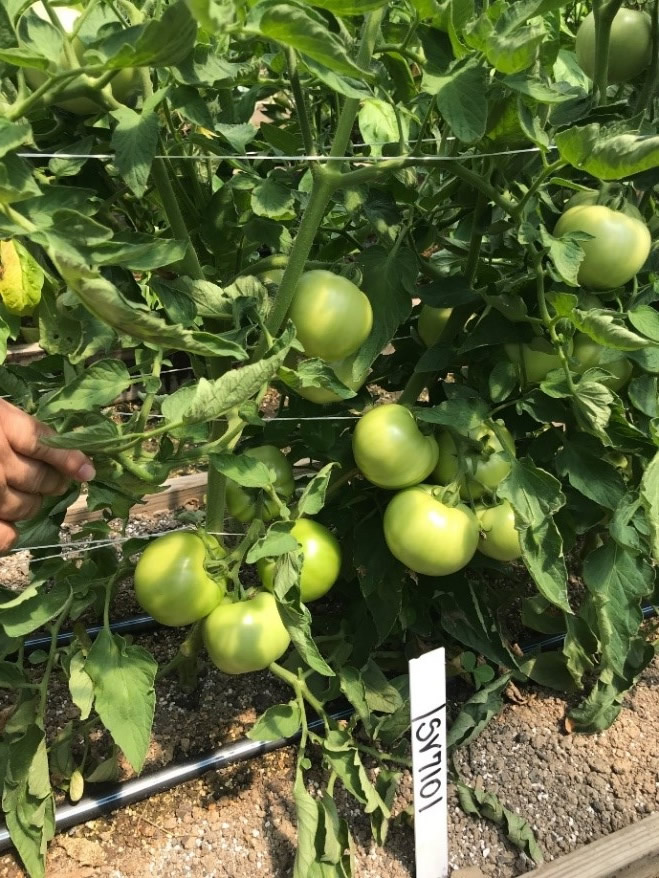
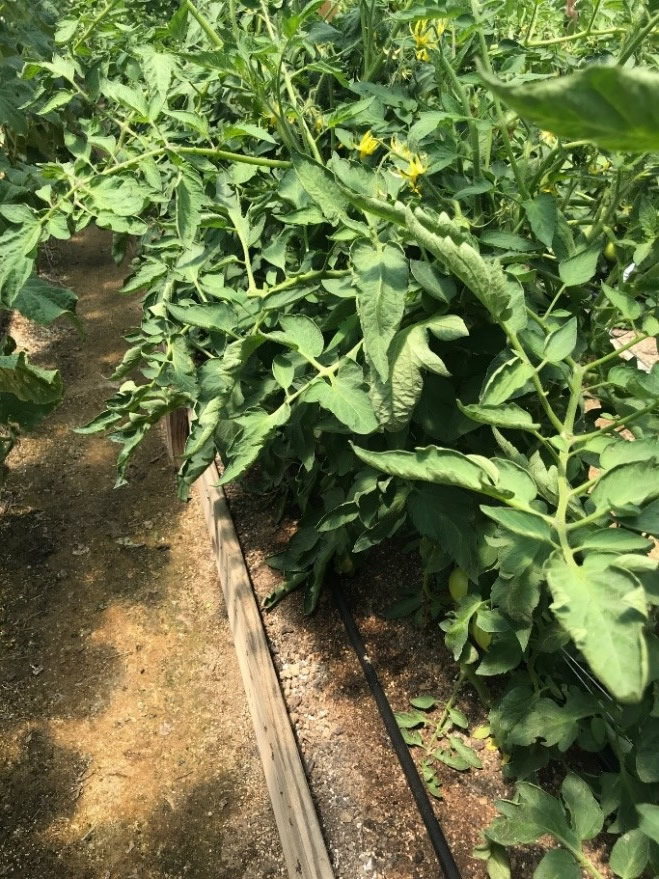
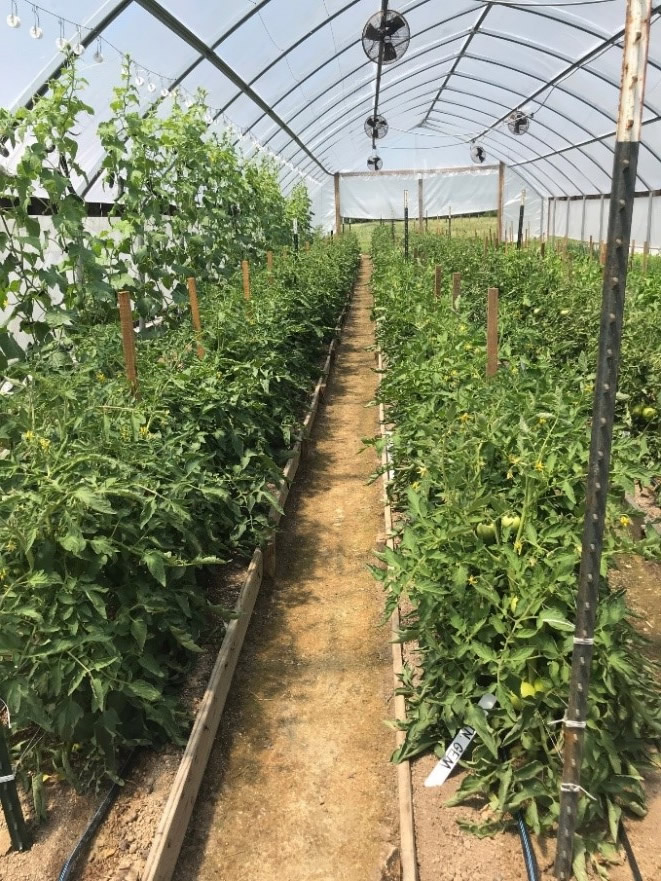
Determinate tomatoes first fruit cluster is sizing nicely (top two photos). Bottom left photo is ‘BHN 589’ determinate tomato that was planted almost 3 weeks later than the others. Bottom right photo: ‘BHN 589’ row on left, variety trial row on right. Interesting that the ‘BHN 589’ plants have more foliage and less fruit set than the row with multiple varieties. Photos by B. Aly.
Bronwyn Aly (618-382-2662; baly@illinois.edu)
Fruit and Vegetable Pest Management
Modified Growing Degree Days (Base 50⁰ F, January 1 through June 4)
Station Location |
Actual Total |
Historical Average (11 year) |
One- Week Projection |
Two-Week Projection |
Freeport |
486 |
514 |
595 |
735 |
St. Charles |
463 |
488 |
565 |
696 |
DeKalb |
461 |
564 |
575 |
720 |
Stelle |
578 |
629 |
700 |
851 |
Peoria |
669 |
670 |
792 |
943 |
Monmouth |
606 |
628 |
725 |
872 |
Champaign |
768 |
691 |
897 |
1054 |
Springfield |
817 |
769 |
952 |
1115 |
Perry |
799 |
727 |
923 |
1073 |
Brownstown |
873 |
850 |
1013 |
1178 |
Olney |
913 |
828 |
1053 |
1217 |
Belleville |
973 |
896 |
1109 |
1263 |
Rend Lake |
1033 |
965 |
1182 |
1355 |
Carbondale |
1054 |
922 |
1195 |
1357 |
Dixon Springs |
1106 |
996 |
1251 |
1416 |
Insect development is temperature dependent. We can use degree days to help predict insect emergence and activity. Degree day accumulations calculated using the Pest Degree-Day Calculator
Kelly Estes, State Survey Coordinator, Illinois Cooperative Agricultural Pest Survey (217-333-1005; kcook8@illinois.edu)
USDA Fruit & Vegetable Advisory Committee Report
The first meeting of the newly appointed USDA Fruit & Vegetable Industry Advisory Committee took place in early May, bringing together producers, processors, and distributors from across the nation. Members of the Committee are appointed by Secretary of Agriculture Sonny Perdue and their role is to discuss the most pressing needs of the Fruit & Vegetable Industry and make recommendations to the USDA. On the table at the first meeting were issues around:
- The Produce Safety Rule
- Water regulations (related to FSMA)
- The Buy American Act
- Pesticide drift and volatilization
- Specialty Crop Block Grants and research funding
Representing Illinois fruit and vegetable growers is Molly Gleason with Illinois Stewardship Alliance. Molly coordinates the Buy Fresh Buy Local Central Illinois chapter as well as a number of marketing campaigns to drive demand for local food, and has been working on state policy to support fruit and vegetable growers for the past 6 years. If you have experience or thoughts on any of the issues above, or wish to discuss other issues related to your farm or operation, Molly would love to hear from you. Please reach out at molly@ilstewards.org. For more information about the first meeting, check out Molly's recap here.
Molly Gleason, Communications Director, Illinois Stewardship Alliance (217-528-1563;molly@ilstewards.org)
The Public and their Animals: Regulations and Risks on Your Direct Market Farm
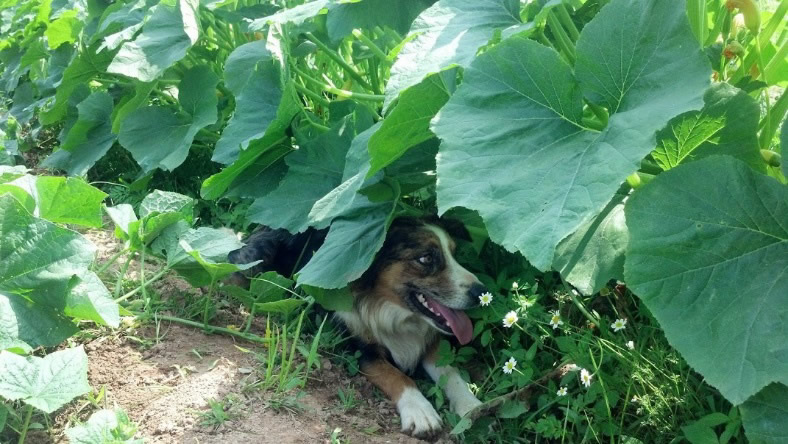
An increasing number of customers are bringing animals with them when they visit farm markets, pick your own farms, or agritainment activities. Animals can pose a food safety risk to produce, introduce disease to farm animals, frighten or upset farm animals. Outside animals can also pose a risk to employees and other market customers and farm visitors. Farmers need to consider these occurrences when keeping in compliance with regulations and buyer requirements specific to food safety and biosecurity to protect their farm animals. The Americans with Disabilities Act (ADA) governs what you are legally allowed to do in regards to customers with service animals visiting your market or on your farm. This fact sheet will cover the specifics of the ADA, animals that are not protected by the ADA regulations, and how to reduce potential risk on your farm from outside animals. States often have regulations that go beyond the federal ADA regulation, information represented in this fact sheet is specific to New Jersey. If you farm in another state please consult the state by state guide linked at the end of this article.
What do the ADA regulations cover?
While many types of animals can provide comfort and emotional support to their owners, only service animals are protected by the ADA, specifically Title II and III. The ADA regulations define “service animal” as dogs, and less commonly miniature ponies, that are individually trained to do work or perform tasks for people with disabilities such as guiding a blind person, alerting people who are deaf, assisting a person in a wheelchair, alerting and protecting a person who is having a seizure, reminding a person with mental illness to take prescribed medications, calming a person with Post Traumatic Stress Disorder (PTSD) during an anxiety attack, or other duties. The work or task that a service animal has been trained to perform must be directly related to the persons disability. Some of these disabilities are obvious, others are not.
What questions can you legally ask?
When it is not obvious to you that an animal is a service animal you may ask just two questions to determine if the animal is a service animal.
- Is the service animal required because of a disability?
2) What work or task has the service animal been trained to perform?
The service animal must have been trained to perform a specific task or work for a person with a disability in order to qualify for protection under the ADA regulations. Note that service animals do not always wear vests or harnesses, and there is no paperwork or ID Card carried by anyone with a service animal.
What questions are you legally prevented from asking?
1) You may not ask about the persons disability.
2) You may not ask for proof of the persons disability.
3) You may not ask for documentation or proof that the service animal is trained.
4) You may not ask for an animal health certificate.
What should you do once you are satisfied the animal is a service animal?
1) Inform the handler which areas of the farm are open to the service animal and handler.
2) Inform the handler where the handwashing areas are located, and that they should wash their hands before handling and consuming produce.
3) Inform the handler of the proper area for the service animal to relieve themselves.
4) Inform the handler of where plastic bags and trash cans are available to them to dispose of fecal material.
5) Inform the handler of any farm policies specific to service animals.
Are comfort or emotional support animals protected by regulations?
Neither comfort nor emotional support animals are covered by the ADA regulations. Without the ADA regulatory protection these animals can be refused entry to your farm without fear of legal ramifications based on risk to your crops, your animals, farm employees or other farm customers.
What risks do outside animals pose for farm livestock and other farm animals?
When outside animals are present on your farm there are diseases that can be spread to and by your farm animals and livestock. Zoonotic diseases are diseases spread between humans and animals and include E. coli O157:H7, salmonella, and others. The most common way for these diseases to spread is through direct contact, indirect contact, vectors, and contaminated food. It has been estimated that six out of ten known infectious diseases impacting humans are spread also by animals. For more information on zoonotic disease risks and preventive controls visit the CDC Zoonotic Diseases webpage: https://www.cdc.gov/onehealth/basics/zoonotic-diseases.html
Can you deny entry to animals on the farm?
In general the ADA regulations state that service animals may be present where the public is normally permitted. You may restrict service animals from specific areas such as produce handling areas used for washing, packing, and storage (risk of food contamination), or livestock areas (natural predator/prey relationships that can upset farm animals or potentially be a source of disease transmission).
What is appropriate behavior for a service animal and their handler?
Service animals should always be under the control of their handler. Service animals must be harnessed, leashed, or tethered, unless these devices interfere with the service animal’s work or the individual’s disability prevents using these devices. Service animals have been trained on how to perform a service to their handler and should be focused on that task.
Can you ask someone with a service animal to leave the farm?
If the service animal is behaving in a way that indicates they are not under the control of their handler, or if the handler is unable to control the animal, you may ask them to leave. Examples of this type of behavior would be: consumption of produce, urination, marking, or defecation in the production areas, excessive barking, or aggressive behavior.
Can service animals go into you-pick areas?
You should consider your production practices and the risk involved with having an animal in your fields when determining what parts of the farm service animals can access. Crops grown in close proximity to the ground are inherently higher risk crops for contamination when compared to crops growing farther from the ground. Crops typically consumed raw are also higher risk, and in many pick-your-own settings the customers are eating produce in the fields as they pick. Contact with animals can increase the risk of contamination of that produce. Handwashing stations should be provided to give the customers an opportunity to clean their hands after touching the service animal.
Can service animals go into farm stores?
Service animals may be given access to store areas that are generally open to the public. Service animals would be prohibited from food processing areas, such as a store kitchen, due to contamination risk.
What should you provide to help reduce risk when service animals are on the farm?
While the presence of service animals on your farm is likely to be a rare event, you should be prepared by having a designated area for service animals to relieve themselves, complete with pick-up bags and a trash can to dispose of fecal material. Handwashing facilities should be available for the handler.
What if I let my customers bring animals onto my farm, without restrictions?
Should you allow animals other than service animals onto your farm be prepared to deal with customers with animals frequently. At minimum you should consider the following:
- Where will these animals urinate and defecate?
- What supplies will you provide to allow proper clean up of defecation? (i.e. plastic bags and a trash can)
- Who will be trained to properly monitor this area to ensure that it does not become a contamination risk or an eyesore for your farm?
- Where will the customer handwashing station be so that their hands can be washed after handling their animal and after managing a defecation event?
- What signage will you need to instruct customers on your expectation for animal behavior and handling at the farm?
- How will you handle a situation when the animal and/or the handler is behaving inappropriately?
What are the steps to enforce your policies when someone wants to bring an animal on the farm?
Your own policies regarding service animals on your farm will dictate the conversation you have with a member of the public who wishes to bring an animal onto your property. Below are two examples of a farm policy:
Service Animals Covered by the ADA Regulations Only |
|
|
|
|
Customers are Permitted to bring Outside Animals onto the Farm Property |
|
|
|
|
|
What do you need to do to comply with the Food Safety Modernization Act/Produce Safety Rule or a buyer required third party audit?
Produce safety inspectors and auditors will focus on the potential risk of contamination with animals on your farm. You can expect questioning to focus on the production areas where the animals are permitted access, the areas that the animals are allowed to relieve themselves, how those areas are maintained, availability of handwashing facilities for the handler, and relevance and prominence of appropriate signage for the handler. Signage should indicate your expectations for the animal handler, locations of areas to support proper handwashing and trash disposal, and appropriate areas for the animal to urinate and defecate.
Where can I learn more about the ADA regulations on service animals?
ADA 2010 Revised Requirements – Service Animals https://www.ada.gov/service_animals_2010.htm
Frequently Asked Questions about Service Animals and the ADA https://www.ada.gov/regs2010/service_animal_qa.html
State Specific Regulatory Table
https://www.animallaw.info/topic/table-state-assistance-animal-laws
Rutgers Cooperative Extension would like to thank The Seeing Eye, Inc., the New Jersey State Board of Agriculture, New Jersey Farm Bureau and the New Jersey Department of Agriculture for their assistance in developing this fact sheet.
Meredith Melendez, Agricultural Agent, Rutgers Cooperative Extension of Mercer County
Wesley Kline, Agricultural Agent, Rutgers Cooperative Extension of Cumberland County
This article originally appeared in the Rutgers Cooperative Extension Plant & Pest Advisory https://plant-pest-advisory.rutgers.edu/. We thank the authors for modifying it and allowing us to share it in the Illinois Fruit & Vegetable News.
Potato Leafhopper on Apples
Potato Leafhopper information for apples, green beans, potatoes, and other vegetable crops taken from articles previously written by Dr. Rick Weinzierl for the IFVN. These are being reissued as a reminder to growers to be on the lookout for these insect pests, especially with the continued weather fronts moving through our region.
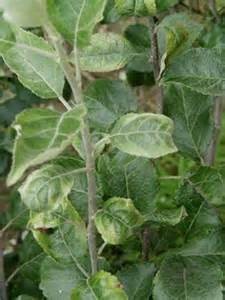
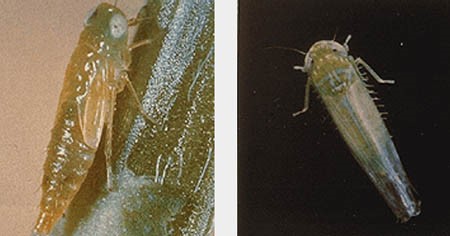
Left to right: cupping of apple leaves as a result of potato leafhopper feeding, potato leafhopper nymph, and adult.
This is the time of the season when potato leafhoppers migrate into Illinois from the south on weather fronts. They feed on a wide range of fruit, vegetable, field crop, and landscape plants by inserting their needle-like mouthparts (stylets) into leaves and shoots, then sucking out plant fluids. In the process, they inject a salivary toxin into the leaves or shoots, causing a variety of symptoms, all of which are sometimes referred to as hopper burn. In apples, potato leafhopper feeding causes cupping of new leaves and greatly reduced growth of new shoots. In most years, potato leafhopper damage is most common in young trees that are not yet bearing fruit, as growers are not spraying them regularly for other insect pests (and coincidentally killing potato leafhopper). In addition, the switch from organophosphates such as Imidan and Guthion to alternatives such as Altacor, Rimon, and Delegate for codling moth control in apples allows potato leafhopper infestations to develop in fruit-bearing blocks, because these insecticides do not control potato leafhoppers.
Sample for potato leafhoppers by examining the undersides of leaves. Look for light-green, narrow, small (< 1/8 inch long) insects that tend to move sideways (instead of forward or backward) when disturbed. Thresholds suggested for potato leafhopper control range from treating whenever adults and nymphs are found on young trees to 1 adult or nymph per leaf on older trees where vigorous new growth is less important. Unlike white apple leafhopper (which is resistant to several insecticides), potato leafhopper is susceptible to most of the broad-spectrum insecticides used in apples –Imidan, neonicotinoids such as Assail and Calypso, pyrethroids such as Danitol (and others), and carbamates such as Lannate and Sevin but remember to look in your Midwest Fruit Pest Management Guide 2019-2020 at https://ag.purdue.edu/hla/hort/documents/id-465.pdf for specifics. Again, Altacor, Belt, Delegate, and Rimon do not control potato leafhopper.
Potato Leafhopper on Green Beans and Potatoes
As noted above under the Potato Leafhopper on Apples heading, now is the time to expect potato leafhopper immigration from the south on weather fronts. In Illinois vegetable crops, potato leafhopper is particularly damaging to potatoes and green beans. As it feeds by inserting its stylet into leaves and sucking out plant fluids, it also injects its saliva into the plant. The saliva is toxic to plants, and leaves typically yellow and curl and plant growth is stunted. See the 2019 Midwest Vegetable Production Guide at https://ag.purdue.edu/btny/midwest-vegetable-guide/Documents/2019/ID-56_2019.pdf for listings of insecticides registered for use against potato leafhopper on specific crops.

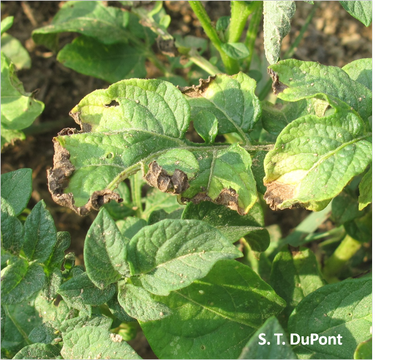
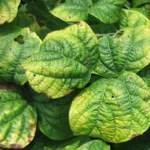
Potato leafhoppers and injury to potato and green bean leaves. (Photos, L to R, are from Michigan State University, Penn State University, and the University of Massachusetts.)
Rick Weinzierl (Weinzierl Fruit and Consulting, LLC, raweinzierl@gmail.com)
Less Seriously
https://inews.co.uk/light-relief/jokes/fathers-day-jokes-best-one-liners-card-message/
Happy Father’s Day to one of my favourite ever parents.
“For Father’s Day we got my dad a t-shirt that says ‘Do Not Resuscitate.’ He wears it whenever mum takes him to the ballet.“ – Greg Tamblyn
I wanted to say happy Father’s Day to my hero and role model. Unfortunately I don’t have one so I’ll say it to you instead.
I would give you what you really want on Father’s Day, but I can’t afford to move out yet.
I love how we don’t even need to say out loud that I am your favourite child. It’s a really special bond we share.
“There should be a children’s song ‘If you’re happy and you know it, keep it to yourself and let your dad sleep.’” – Jim
I smile because you are my father. I laugh because there is nothing you can do about it.
Happy Father’s Day dad, you’ve always been like a father to me.
Dad, your father’s day gift is another year of not having to pay for my wedding.
I was going to give you the most amazing gift ever… then I remembered you already have me.
Happy Father’s Day from one of your most legitimate children.
Happy Father’s Day to someone who inexplicably loves signing his name in each of his text messages.
“Father’s Day, when you get that lethal combination of alcohol and new power tools.” – David Letterman
Well done – you rank in the top 10 of all the dads I’ve ever had.
Dad, thanks for working so hard to pay for the TV that actually raised me.
You’ve always been my favourite ATM.
“To be a successful father… there’s one absolute rule: when you have a kid, don’t look at it for the first two years.” – Ernest Hemingway
Happy Father’s Day. I’m sorry I spent all of your money!
“I have mixed emotions when I receive my Father’s Day gifts. I’m glad my children remember me. I’m disappointed they think I dress like that.” – Mike Dugan
Thanks for helping me out financially so I can be an independent person and not rely on others.
“If it wasn’t for Father’s Day, my dad would only have two ties in his closet.” – Melanie White
“A father carries pictures where his money used to be.” – Anonymous
Please accept this Father’s Day card as a token of my poverty.
“My Father had a profound influence on me, he was a lunatic.” – Spike Milligan
You’re by far the best dad I could have asked for… until you start dancing!
University of Illinois Extension Specialists in Fruit and Vegetable Production & Pest Management
Extension Educators – Local Food Systems and Small Farms |
||
Bronwyn Aly, Gallatin, Hamilton, Hardin, Pope, Saline, and White counties |
618-382-2662 |
|
Katie Bell, Franklin, Jackson, Perry, Randolph, & Williamson counties |
618-687-1727 |
|
Sarah Farley, Lake & McHenry counties |
847-223-8627 |
|
Nick Frillman, Woodford, Livingston, & McLean counties |
309-663-8306 |
|
Laurie George, Bond, Clinton, Jefferson, Marion, & Washington counties |
618-548-1446 |
|
Zachary Grant, Cook County | 708-679-6889 | |
Doug Gucker, DeWitt, Macon, and Piatt counties |
217-877-6042 |
|
Erin Harper, Champaign, Ford, Iroquois, and Vermillion counties |
217-333-7672 |
|
Grace Margherio, Jackie Joyner-Kersee Center, St. Clair County |
217-244-3547 |
|
Grant McCarty, Jo Daviess, Stephenson, and Winnebago counties |
815-235-4125 |
|
Katie Parker, Adams, Brown, Hancock, Pike and Schuyler counties |
217-223-8380 |
|
Kathryn Pereira, Cook County |
773-233-2900 |
|
James Theuri, Grundy, Kankakee, and Will counties |
815-933-8337 |
|
Extension Educators – Horticulture |
||
Chris Enroth, Henderson, Knox, McDonough, and Warren counties |
309-837-3939 |
|
Richard Hentschel, DuPage, Kane, and Kendall counties |
630-584-6166 |
|
Andrew Holsinger, Christian, Jersey, Macoupin, & Montgomery counties |
217-532-3941 |
|
Extension Educators - Commercial Agriculture |
||
Elizabeth Wahle, Fruit & Vegetable Production |
618-344-4230 |
|
Nathan Johanning, Madison, Monroe & St. Clair counties |
618-939-3434 |
|
Campus-based Extension Specialists |
||
Kacie Athey, Entomology |
217-244-9916 |
|
Mohammad Babadoost, Plant Pathology |
217-333-1523 |
|